Historic Monuments of Ancient Kyoto (Kyoto, Uji and Otsu Cities)
The UNESCO World Heritage Site Historic Monuments of Ancient Kyoto (Kyoto, Uji and Otsu Cities) encompasses 17 locations in Japan, within the city of Kyoto and its immediate vicinity. The locations are in three cities: Kyoto and Uji in Kyoto Prefecture; and Ōtsu in Shiga Prefecture; Uji and Ōtsu border Kyoto to the south and north, respectively. Of the monuments, 13 are Buddhist temples; three are Shinto shrines; and one is a castle. The properties include 38 buildings designated by the Japanese government as National Treasures, 160 properties designated as Important Cultural Properties, eight gardens designated as Special Places of Scenic Beauty, and four designated as Places of Scenic Beauty. UNESCO listed the site as World Heritage in 1994.
Selection criteria
Kyoto has a substantial number of historic buildings, unlike other Japanese cities that lost buildings to foreign invasions and war; and has the largest concentration of designated Cultural Properties in Japan. Although ravaged by wars, fires, and earthquakes during its eleven centuries as the imperial capital, Kyoto was spared from much of the destruction and danger of World War II. It was saved from the nearly universal firebombing of large cities in Japan in part to preserve it as the primary atomic bomb target. It was later removed from the atomic bomb target list, by the personal intervention of Secretary of War Henry L. Stimson, as Stimson wanted to save this cultural center which he knew from his honeymoon and later diplomatic visits. As a result, Nagasaki was then added as a target.[1][2]
The 17 properties of the World Heritage Site originate from a period between the 10th century and the 19th century, and each is representative of the period in which it was built. The historical importance of the Kyoto region was taken into account by the UNESCO in the selection process.[3]
List of locations
| Name |
Type |
Position |
Picture |
Kamowakeikazuchi Shrine (賀茂別雷神社, Kamo Wake-ikazuchi Jinja)
aka Kamigamo Shrine (上賀茂神社, Kamigamo Jinja) |
shrineShinto shrine |
Kyoto Kyoto Kita-kuKita-ku, Kyoto, 35°03′37″N 135°45′10″E / 35.06028°N 135.75278°E / 35.06028; 135.75278 (Kamigamo Shrine) |
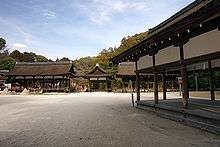 |
| Kamomioya Shrine (賀茂御祖神社, Kamo Mioya Jinja) aka Shimogamo Shrine (下鴨神社, Shimogamo Jinja) |
shrineShinto shrine |
Kyoto Kyoto Sakyou-kuSakyō-ku, Kyoto, 35°02′20″N 135°46′21″E / 35.03889°N 135.77250°E / 35.03889; 135.77250 (Shimogamo Shrine) |
 |
Kyōōgokoku-ji (教王護国寺)
aka Tō-ji (東寺) |
temple ShingonShingon Buddhist temple |
Kyoto Kyoto Minami-kuMinami-ku, Kyoto, 34°58′51.48″N 135°44′48.02″E / 34.9809667°N 135.7466722°E / 34.9809667; 135.7466722 (Tō-ji) |
 |
| Kiyomizu-dera (清水寺) |
temple IndependentIndependent Buddhist temple |
Kyoto Kyoto Higashiyama-kuHigashiyama-ku, Kyoto, 34°59′41.39″N 135°47′6.01″E / 34.9948306°N 135.7850028°E / 34.9948306; 135.7850028 (Kiyomizu-dera) |
 |
| Enryaku-ji (延暦寺) |
temple TendaiTendai Buddhist temple |
Shiga OotsuŌtsu, Shiga, 35°4′13.62″N 135°50′27.33″E / 35.0704500°N 135.8409250°E / 35.0704500; 135.8409250 (Enryaku-ji) |
 |
| Daigo-ji (醍醐寺) |
temple ShingonShingon Buddhist temple |
Kyoto Kyoto Fushimi-kuFushimi-ku, Kyoto, 34°57′3.57″N 135°49′10.51″E / 34.9509917°N 135.8195861°E / 34.9509917; 135.8195861 (Daigo-ji) |
 |
| Ninna-ji (仁和寺) |
temple ShingonShingon Buddhist temple |
Kyoto Kyoto Ukyou-kuUkyō-ku, Kyoto, 35°1′51.63″N 135°42′49.58″E / 35.0310083°N 135.7137722°E / 35.0310083; 135.7137722 (Ninna-ji) |
 |
| Byōdō-in (平等院) |
temple Jodo shu TendaiBuddhist temple jointly held by Jōdo shū and Tendai |
Kyoto UjiUji, Kyoto, 34°53′21.45″N 135°48′27.69″E / 34.8892917°N 135.8076917°E / 34.8892917; 135.8076917 (Byōdō-in) |
 |
| Ujigami Shrine (宇治上神社, Ujigami Jinja) |
shrineShinto shrine |
Kyoto UjiUji, Kyoto, 34°53′31″N 135°48′41″E / 34.89194°N 135.81139°E / 34.89194; 135.81139 (Ujigami Shrine) |
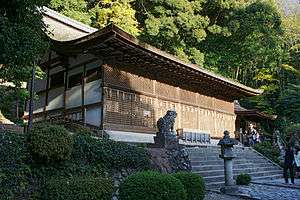 |
| Kōzan-ji (高山寺) |
temple ShingonShingon Buddhist temple of the Omuro school |
Kyoto Kyoto Ukyou-kuUkyō-ku, Kyoto, 35°3′36.39″N 135°40′42.85″E / 35.0601083°N 135.6785694°E / 35.0601083; 135.6785694 (Kōzan-ji) |
 |
| Saihō-ji (西芳寺) aka Moss temple (苔寺, Koke-dera) |
temple RinzaiRinzai Zen Buddhist temple |
Kyoto Kyoto Nishikyou-kuNishikyō-ku, Kyoto, 34°59′31.06″N 135°40′59.93″E / 34.9919611°N 135.6833139°E / 34.9919611; 135.6833139 (Saihō-ji) |
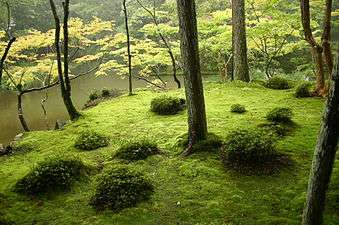 |
| Tenryū-ji (天龍寺) |
temple Rinzai TenryuRinzai Zen Buddhist temple of the Tenryū school |
Kyoto Kyoto Ukyou-kuUkyō-ku, Kyoto, 35°0′57.47″N 135°40′25.58″E / 35.0159639°N 135.6737722°E / 35.0159639; 135.6737722 (Tenryū-ji) |
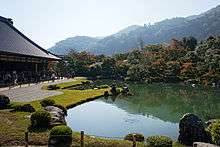 |
| Rokuon-ji (鹿苑寺) aka Temple of the Golden Pavilion (金閣寺, Kinkaku-ji) |
temple RinzaiRinzai Zen Buddhist temple |
Kyoto Kyoto Kita-kuKita-ku, Kyoto, 35°2′21.85″N 135°43′45.71″E / 35.0394028°N 135.7293639°E / 35.0394028; 135.7293639 (Kinkaku-ji) |
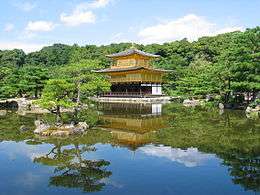 |
| Jishō-ji (慈照寺) aka Temple of the Silver Pavilion (銀閣寺, Ginkaku-ji) |
temple RinzaiRinzai Zen Buddhist temple |
Kyoto Kyoto Sakyou-kuSakyō-ku, Kyoto, 35°1′36.75″N 135°47′53.7″E / 35.0268750°N 135.798250°E / 35.0268750; 135.798250 (Ginkaku-ji) |
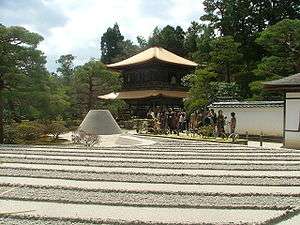 |
| Ryōan-ji (竜安寺、龍安寺, The Temple of the Peaceful Dragon) |
temple Rinzai MyoushinjiRinzai Zen Buddhist temple of the Myōshinji school |
Kyoto Kyoto Ukyou-kuUkyō-ku, Kyoto, 35°2′4.18″N 135°43′5.71″E / 35.0344944°N 135.7182528°E / 35.0344944; 135.7182528 (Ryōan-ji) |
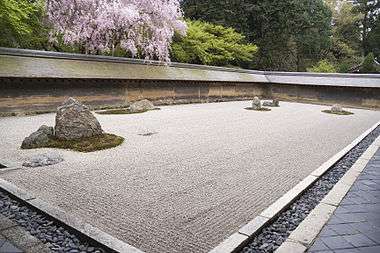 |
| Nishi Hongan-ji (西本願寺) |
temple Jodo ShinshuJodo Shinshu Buddhist temple and world headquarters |
Kyoto Kyoto Shimogyou-kuShimogyō-ku, Kyoto, 34°59′31.37″N 135°45′5.81″E / 34.9920472°N 135.7516139°E / 34.9920472; 135.7516139 (Nishi Hongan-ji) |
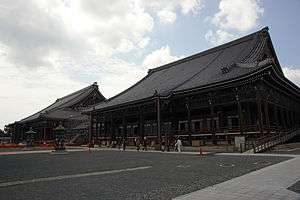 |
| Nijō Castle (二条城, Nijō-jō) |
castleCastle |
Kyoto Kyoto Nakagyou-kuNakagyō-ku, Kyoto, 35°0′50.96″N 135°44′51.0″E / 35.0141556°N 135.747500°E / 35.0141556; 135.747500 (Nijō Castle) |
 |
|
See also
References
- ↑ The Manhattan Project, Department of Energy at mbe.doe.gov
- ↑ http://www.hyperhistory.net/apwh/bios/b4stimson-henrylewis.htm
- ↑ ICOMOS (28 September 1993). "Advisory Body Evaluation" (PDF). Retrieved 2009-04-10.
External links















